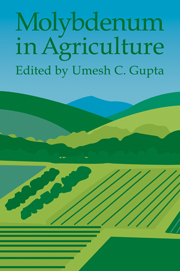Book contents
- Frontmatter
- Contents
- List of contributors
- Preface
- 1 Introduction
- 2 Chemistry and Mineralogy of Molybdenum in Soils
- 3 Distribution and Mobility of Molybdenum in the Terrestrial Environment
- 4 Biochemical Significance of Molybdenum in Crop Plants
- 5 Soil and Plant Factors Affecting Molybdenum Uptake by Plants
- 6 Analytical Techniques for Molybdenum Determination in Plants and Soils
- 7 Testing for Molybdenum Availability in Soils
- 8 Molybdenum Availability in Alkaline Soils
- 9 Deficient, Sufficient, and Toxic Concentrations of Molybdenum in Crops
- 10 Symptoms of Molybdenum Deficiency and Toxicity in Crops
- 11 Sources and Methods for Molybdenum Fertilization of Crops
- 12 Yield Responses to Molybdenum by Field and Horticultural Crops
- 13 Responses of Forage Legumes and Grasses to Molybdenum
- 14 Molybdenum and Sulfur Relationships in Plants
- 15 Molybdenum in the Tropics
- Index
4 - Biochemical Significance of Molybdenum in Crop Plants
Published online by Cambridge University Press: 10 December 2009
- Frontmatter
- Contents
- List of contributors
- Preface
- 1 Introduction
- 2 Chemistry and Mineralogy of Molybdenum in Soils
- 3 Distribution and Mobility of Molybdenum in the Terrestrial Environment
- 4 Biochemical Significance of Molybdenum in Crop Plants
- 5 Soil and Plant Factors Affecting Molybdenum Uptake by Plants
- 6 Analytical Techniques for Molybdenum Determination in Plants and Soils
- 7 Testing for Molybdenum Availability in Soils
- 8 Molybdenum Availability in Alkaline Soils
- 9 Deficient, Sufficient, and Toxic Concentrations of Molybdenum in Crops
- 10 Symptoms of Molybdenum Deficiency and Toxicity in Crops
- 11 Sources and Methods for Molybdenum Fertilization of Crops
- 12 Yield Responses to Molybdenum by Field and Horticultural Crops
- 13 Responses of Forage Legumes and Grasses to Molybdenum
- 14 Molybdenum and Sulfur Relationships in Plants
- 15 Molybdenum in the Tropics
- Index
Summary
Introduction
Many early studies reported the molybdenum (Mo) requirements of bacteria (Bortels, 1930; Horner et al., 1942), fungi (Steinberg, 1936, 1937), green algae (Arnon et al., 1955), and higher plants (Arnon and Stout, 1939) long before recognition of its various biochemical and physiological functions. Because of subsequent advances in biochemical and physiological research techniques and instrumentation, Mo has been found to be an essential constituent of several important enzymes, besides having a range of nonspecific roles in plant metabolism. This chapter reviews the information available on the biochemical and physiological roles of Mo in crop plants.
Chemical Basis for the Roles of Molybdenum in Biochemical Reactions
It is worthwhile to examine the chemistry of Mo to emphasize what makes it suitable for catalyzing many unique biochemical reactions. Molybdenum is a transition element with an atomic number of 42 and electronic configurations of Is2, 2s22p6, 3s23p63d10, 4s24p64d5, and 5s1. The outermost 4d electrons can be easily removed to yield several oxidation states of Mo, ranging from zero to VI. However, the oxidation states IV, V, and VI are more common and involve only low potentials. Higher oxidation states of Mo have a tendency to form oxocomplexes. As Mo(VI) has no electron in its d orbital, it accepts two e– from an O2– anion to form a sigma (σ) bond. As the Mo—O bond length is short, the d orbital of Mo suffers sidewise weak overlap with the p orbitals of an O atom, to yield a slightly double-bond (Mo=O°) character.
- Type
- Chapter
- Information
- Molybdenum in Agriculture , pp. 47 - 70Publisher: Cambridge University PressPrint publication year: 1997
- 9
- Cited by

